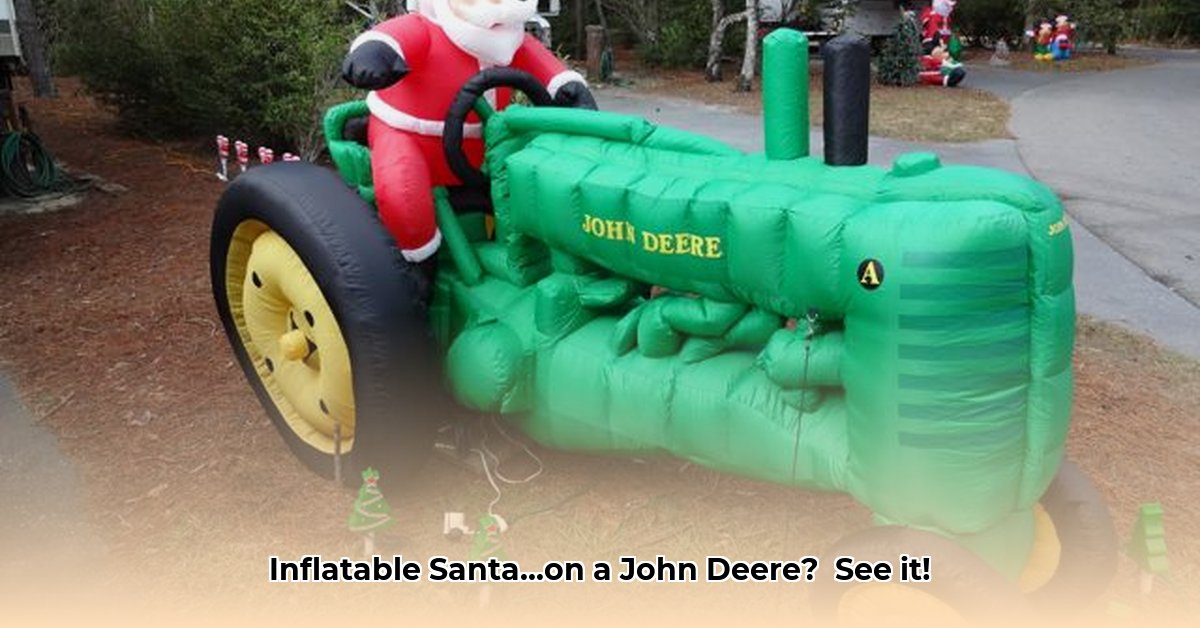
Inflatable Santa John Deere Tractor: A Holiday Trend with Sustainable Implications
This holiday season, an unexpected trend is capturing attention: the inflatable Santa Claus riding a John Deere tractor. More than a quirky decoration, this phenomenon reveals a surprising intersection of consumer behavior, marketing strategies, and the potential for advancing sustainable agriculture practices. This article analyzes the market opportunity, assesses environmental considerations, and proposes actionable steps for maximizing positive impact. For more images of John Deere tractors, see pictures here.
A Booming Market: Holiday Cheer Meets Agricultural Innovation
The inflatable Santa on a John Deere tractor demonstrates a substantial and concentrated holiday market demand. Online sales data from major retailers like Amazon and direct-to-consumer channels from John Deere indicate strong sales during a short, intense holiday period. This seasonal surge presents both opportunities and challenges for manufacturers and retailers, necessitating precise inventory management and strategic marketing campaigns. How can companies best leverage this short window of high demand? Careful planning is key.
How much revenue is John Deere seeing from this unexpected hit? While exact figures remain undisclosed, the potential is significant given the high volume of sales observed. This revenue stream presents a unique opportunity for reinvestment. What if a portion of these holiday profits were allocated towards furthering sustainable agricultural practices? This possibility offers a fascinating link between seemingly disparate consumer trends and environmental responsibility.
Environmental Impact: A Necessary Consideration
While the inflatable Santa tractor brings festive cheer, its environmental impact demands careful consideration. Manufacture requires significant resources including plastic and energy, raising questions about both the manufacturing process and post-holiday disposal. Many of these inflatable decorations end up in landfills, contributing to plastic waste. This necessitates a shift towards responsible manufacturing and disposal methods. How can we mitigate the environmental impact of these festive products?
Actionable Steps for a Greener Holiday Season
To harness the positive potential of this trend while minimizing negative environmental consequences, a multi-pronged approach is required.
John Deere: Improve manufacturing efficiency to maximize holiday sales, invest in research and development of eco-friendly materials (e.g., biodegradable plastics), and allocate a portion of profits to sustainable farming technology R&D.
Retailers (e.g., Amazon): Implement targeted holiday marketing strategies to capitalize on peak demand and collaborate with John Deere to highlight and promote more sustainable versions of the inflatable tractor.
Consumers: Make informed purchasing decisions by considering the environmental impact and supporting companies committed to sustainability.
Environmental Groups: Conduct thorough life-cycle assessments of inflatable products, identify areas for improvement, and advocate for industry-wide adoption of sustainable manufacturing practices.
Risk Assessment: Navigating Potential Challenges
Several factors could impact the long-term success and sustainability of this holiday trend. A thorough risk assessment is crucial:
| Risk Factor | Likelihood | Potential Impact | Mitigation Strategy |
|---|---|---|---|
| Negative environmental impact | Moderate | High | Transition to sustainable materials, improved recycling and disposal programs. |
| Supply chain disruptions | Moderate | Medium | Diversify suppliers, secure key materials well in advance. |
| Declining consumer demand | Low | Low | Conduct ongoing market research to gauge future interest. |
| Negative brand perception | Low | Medium | Address environmental concerns head-on; promote any sustainable manufacturing or investment efforts aggressively. |
Reinvesting Profits: Fueling Sustainable Agriculture R&D
"The success of the inflatable Santa tractor presents a unique opportunity for John Deere to further its commitment to sustainable agriculture," says Dr. Emily Carter, Professor of Chemical and Biomolecular Engineering at Princeton University. "Reinvesting a portion of the profits into R&D can accelerate innovation in areas like precision agriculture and resource management."
Key Considerations for R&D Investment:
Enhanced Connectivity: Investment in robust wireless infrastructure for precision farming systems improves data collection and insights, particularly in remote areas.
User-Friendly Interfaces: Improving the user experience of platforms like MyJohnDeere through simplified interfaces and improved training maximizes adoption rates among farmers.
Cybersecurity Upgrades: Protecting farmer data through enhanced security protocols is crucial for maintaining trust and protecting the company's reputation.
AI and Computer Vision: Exploring AI and computer vision technologies can lead to more efficient resource utilization, reducing waste and environmental impact.
Collaborative Partnerships: Joint development of products and services with input suppliers using data insights can optimize supply chain management, reduce fertilizer waste, and improve resource efficiency.
Data-Driven Insurance: Investing in the research and development of data-driven insurance products offers enhanced financial security for farmers.
The inflatable Santa Claus John Deere tractor represents a compelling case study in the convergence of consumer trends, market dynamics, and environmental responsibility. By adopting a strategic and proactive approach, stakeholders can transform a seemingly simple holiday decoration into a catalyst for positive change in the agricultural sector.